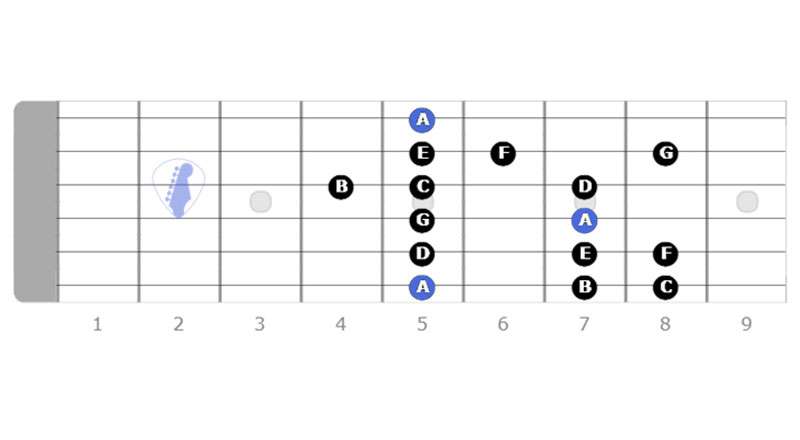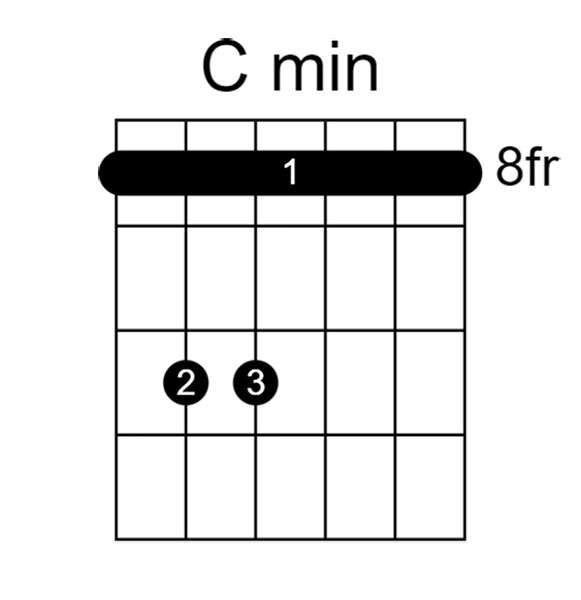The natural minor guitar scale is a seven-note musical scale that is widely used in various music genres due to its emotional and dramatic qualities.
It follows a specific pattern of whole-steps and half-steps and is closely related to the Aeolian mode, which is the sixth mode of the major scale.
Finally, the natural minor scale, or “minor scale” for short, is an essential scale for beginners to learn as it provides a foundation for playing solos, improvisation, and composing music in minor keys.
Understanding the natural minor scale’s pattern and how it relates to the guitar fretboard can greatly improve a guitar player’s skills & knowledge. In this article we will cover the theory, lay out a couple examples across the fretboard, and show you some related guitar chords to cover all bases.

Understanding the Natural Minor Scale
Intervals & Scale Degrees
The interval formula of the natural minor scale is:
Whole-Half-Whole-Whole-Half-Whole-Whole
To lay out an example of this formula & the related scale degrees, let’s take the A natural minor scale:
The notes in the A natural minor scale are: A, B, C, D, E, F, G, and A (an octave higher)
The intervals between these notes are:
A – B (Whole)
B – C (Half)
C – D (Whole)
D – E (Whole)
E – F (Half)
F – G (Whole)
G – A (Whole)
The scale degrees of the A natural minor scale are:
A – Tonic (1st degree)
B – Supertonic (2nd degree)
C – Mediant (3rd degree)
D – Subdominant (4th degree)
E – Dominant (5th degree)
F – Submediant (6th degree)
G – Leading tone (7th degree)
Understanding the intervals and scale degrees of the natural minor scale can help you identify the notes, construct chords, and play solos or melodies in minor keys.
Minor Scale vs Major Scale: The Difference
The difference between the major scale and minor scale in terms of sound or mood on guitar is significant. The major scale has a bright and happy sound that tends to create a feeling of positivity and cheerfulness. In contrast, the minor scale has a darker and more melancholic sound that can evoke feelings of sadness, introspection, and drama.
In general, the major scale is associated with upbeat and optimistic music genres such as pop, country, and rock. In contrast, the minor scale is more often used in more somber and emotional genres such as blues, jazz, hard rock & metal.
When playing guitar, the difference in sound and mood between the major and minor scales can be heard in the chords and melodies played. Major chords tend to sound bright and happy, while minor chords sound more melancholic and emotional. By using major and minor scales in contrast, guitar players can create a range of different moods, emotions, & nuance in their music.
Relative Scales
Relative scales are scales that share the same set of notes but have different tonics or starting notes. In other words, a relative scale is a major scale and its natural minor scale that share the same key signature. For example, the relative minor scale is always a minor third below the major scale.
For instance, the relative minor of the C major scale is the A minor scale. Both scales share the same key signature of no sharps or flats. The notes in the A natural minor scale are A, B, C, D, E, F, and G, which are also the notes in the C major scale.
The difference between the two scales is that the A minor scale starts and ends on A, making it a natural minor scale, whereas the C major scale starts and ends on C, making it a major scale.
Relative scales are important to understand because they allow for easy modulation between major and minor keys in music. By knowing the relative minor scale of a major scale, for example, a guitarist can use the same set of notes to play in both the major and minor keys, making it easier to switch between them during a performance or composition.
Natural Minor Scale Examples
A minor (2 Octaves)

A minor (Full Fretboard)

Natural Minor Guitar Chords
If you need help with reading these chord charts, check out our article on how to interpret guitar chord diagrams
Cm

Related: More ways to play the Cm guitar chord
Am

Dm

Related: Check out more easy to play minor chords
Other Minor Scales
Harmonic Minor
The harmonic minor scale is a variation of the natural minor scale that is often used in music to create a unique sound and add tension to melodies and harmonies.
The raised seventh degree of the scale creates a leading tone that strongly resolves to the tonic note, giving the scale a distinct and powerful sound. The harmonic minor scale is commonly used in genres such as classical, jazz, and metal music. You can learn more about the harmonic minor scale in this article.
Melodic Minor
The melodic minor scale on the other hand, is a variation of the natural minor scale that features a raised sixth and seventh degree when ascending, and reverts to the natural minor scale when descending.
This creates a unique sound that is both bright and melancholic. The raised sixth and seventh degrees allow for a greater range of expression and flexibility in playing, making it a popular choice in jazz and other genres that emphasize improvisation.
Frequently Asked Questions
What is the scale of A minor natural?
The A minor natural scale consists of the following notes: A, B, C, D, E, F, and G. It’s also known as the Aeolian mode (key of A) and is the relative minor of the C major scale.
What is the difference between minor and natural minor scale?
When guitarists refer to the “minor scale”, they are most of the time referring to the natural minor scale, also known as the Aeolian mode.
This is because there are actually 3 different types of minor scales: harmonic, melodic, & natural.
So the minor scale is actually a category of scales but is often used interchangeably with just the natural minor version. The harmonic & melodic variants are most commonly labeled respectively.
Is natural minor the same as pentatonic minor?
No, the natural minor scale and pentatonic minor scale are not the same. The natural minor scale is a seven note scale, while the pentatonic minor scale is a five note scale that omits the second and sixth degrees of the natural minor scale.
The pentatonic minor scale is a subset of the natural minor scale and follows a different pattern of intervals. The minor pentatonic is most commonly used in blues & rock genres due to its simplicity and versatility, while the natural minor scale is used in a wider variety of genres and is one of the three main types of minor scales (harmonic, melodic, natural).
